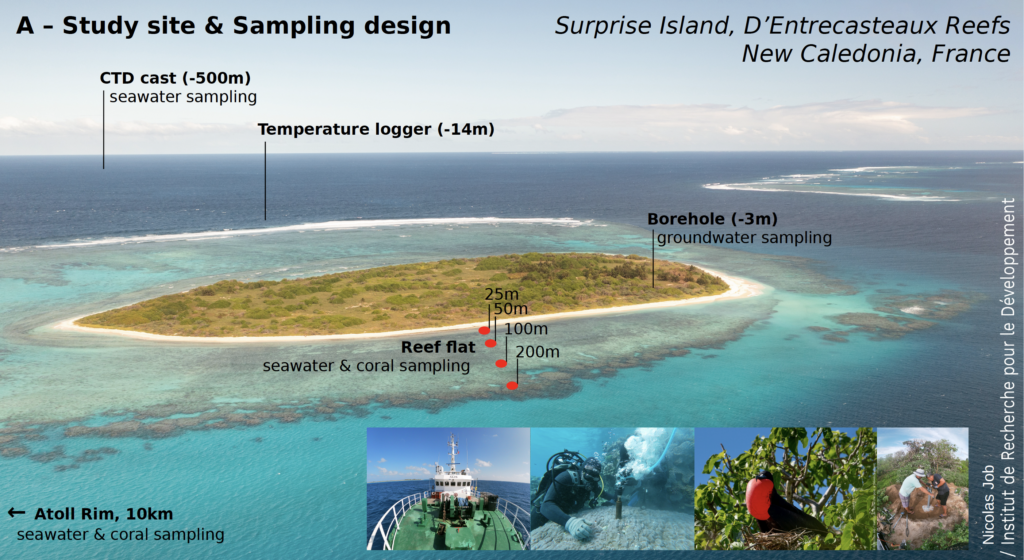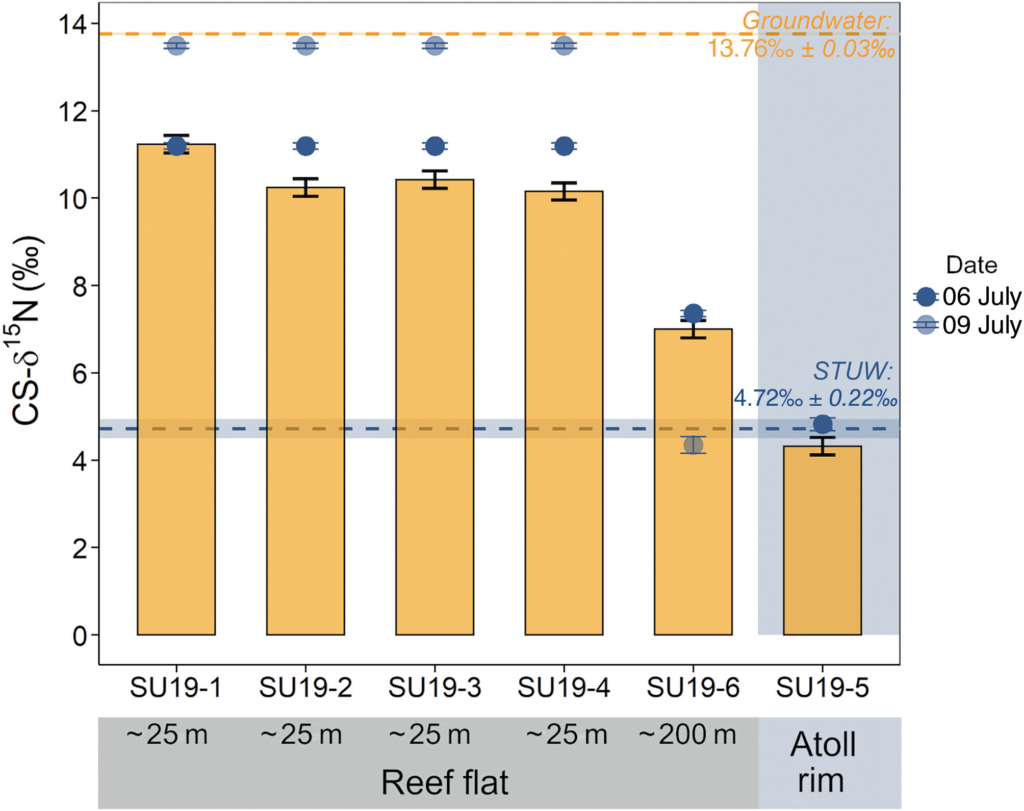A new paper in Limnology and Oceanography, has recently been published by one of the SPP 2299 projects, NITROCENE, led by Alfredo Martínez-García. This project is a collaboration between the Max Planck Institute of Chemistry (Mainz, Germany), and the Laboratoire des Sciences de l’Environnement Marin – LEMAR (Brest, France).
Nic Duprey and Noémie Choisnard, the first authors of the paper, broke down the main findings of the research here.
What is the main finding of your research?
Nitrogen transfer across ecosystem boundaries is a major determinant of habitat dynamics, structure, and productivity. In oligotrophic regions of the ocean, small and isolated ecosystems such as tropical islands are particularly dependent on exogenous nitrogen provided by various animal vectors like seabirds. Yet, the processes involved in seabird-derived nitrogen transfer along the land-sea continuum remain elusive. This study is based on innovative stable nitrogen and oxygen isotope measurements of nitrate and also nitrogen isotopes on coral skeletons. This dataset permitted us to demonstrate that the groundwater lens, present underneath coral islets, plays a significant role during the transfer of seabird-derived guano along the land-ocean interface.
It was shown that seabird-derived nitrogen can be a significant source of nitrogen for coral reef organisms up to 200 meters from the coastline. The groundwater body acts as a biological reactor, oxidizing the seabird-derived nitrogen into nitrate and acts as an important nitrogen reservoir, with nitrate concentrations in the groundwater being 1000 times greater than the surrounding seawater.
One of the key findings of this study is that coral skeleton stable nitrogen isotopes have the potential to record the inputs of nitrogen derived from guano to the reef over time.

Figures from the publication Choisnard, Duprey et al. (2024, https://doi.org/10.1002/lno.12485) – show the dynamic nature of nitrogen incorporation in coral skeletons. Corals SU19-1 to SU19-4 were collected 25 m and SU19-6 200 m from shore on the reef flat. Coral SU19-5 was collected at the atoll rim site (shown in the figure on the above, red dots and to the right with yellow bars). As such CS-δ15N records have the potential to unveil the dynamic of the various N-sources present on the reef like groundwater (orange dashed line) and oceanic water identified as STUW (blue dashed line) over time, using coral cores.
Full figure captions from the publication – Choisnard, Duprey et al. (2024, https://doi.org/10.1002/lno.12485) are available below.

What are the implications of your research?
Being able to reconstruct the contribution of seabird-derived nitrogen and ocean-derived nitrogen from coral skeleton records is extremely valuable to determine the impact of seabird population on the nitrogen inputs to the adjacent coral reef ecosystem over time. This is particularly relevant for islands that are suffering from rat introduction, indeed, rats typically feed on the defenceless seabird chicks, reducing dramatically the size of the bird population on infested islands. The influence of rat introduction and rat eradication programmes on the nitrogen cycle of these islands remains unknown and the cost/benefit of rat removal campaigns on isolated islands is currently hotly debated among policymakers, conservationists and ecologists. The ability to use coral skeleton nitrogen isotope records to address this issue has key implications for this long-standing debate, potentially helping the community to take relevant actions to help ecosystems conservation.
The coral cores we collected on the reef flat exposed to seabird-derived N seem to be on steroids as they display extraordinarily high growth and calcification rates! The doping effect of seabird poop deserves further investigation….
Publication
Choisnard, N., Duprey, N. N., Wald, T., Thibault, M., Houlbrèque, F., Foreman, A. D., …, Martínez‐García, A. & Lorrain, A. (2024). Tracing the fate of seabird‐derived nitrogen in a coral reef using nitrate and coral skeleton nitrogen isotopes. Limnology and Oceanography. https://doi.org/10.1002/lno.12485
Featured image of a Great frigatebird from Nicolas Job – Institut de Recherche pour le Dèveloppemnet. Blog written by Nic Duprey and edited by Jessica Hargreaves.
Figure captions from publication Choisnard, Duprey et al. (2024, https://doi.org/10.1002/lno.12485) –
Figure 1; Tropical seabird-nesting islands are ideally suited to study the transfer of nutrients along the land–ocean continuum. This study focuses on Surprise Island, Tromelin Island and Grande Glorieuse Island (a). Surprise Island, located in D′ Entrecasteaux Reef, is the main study site of this study (b–d). On this site, water was sampled along a shore-ocean transect (blue points in d at 10, 25, 50, 100, 200, and 400 m from shore) and in the groundwater body (borehole). The water column was also sampled every 100 m between 10 and 500 m depth at an oceanic site where a conductivity, temperature, and depth probe was deployed (CTD, 18.593°S, 163.070°E, b). Six coral cores were retrieved (yellow points, c, d). Four were collected at approximately 25 m offshore at the surface at the island site (SU19-1, SU19-2, SU19-3, SU19-4), one roughly 200 m offshore the island at 5 m depth (SU19-6) and one is the atoll rim site, at approximately 7 m depth (SU19-5, c). The atoll rim site was referred to as a “reference site” in previous studies of the region (e.g., Thibault et al. 2022). The map was generated using the WCMC008_CoralReef2018 and the ESRI World Imagery data files.
Figure 6 from original publication – Comparison of coral skeleton δ15N (CS-δ15N—orange bars, SD ± 0.2 for the analytical error) with the δ15N of (NO3− + NO2−) of the surrounding water mass (blue circles) on 06 July (high tide, darker marker) and 09 July (low tide, lighter marker). Corals SU19-1 to SU19-4 were collected 25 m and SU19-6 200 m from shore on the reef flat. Coral SU19-5 was collected at the atoll rim site (Fig. 1c,d). End-members are represented as dashed lines. As such CS-δ15N records have the potential to unveil the dynamic of the various N-sources present on the reef like groundwater (orange dashed line) and oceanic water identified as STUW (blue dashed line) over time, using coral cores.
